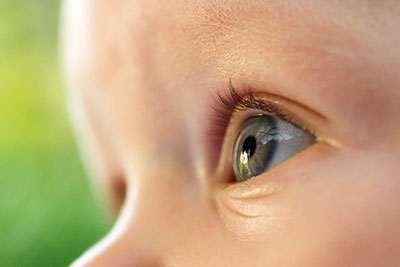Use of an eye-tracking device to measure children’s visual engagement appears to correlate with clinical assessments of autism, offering a potential aid in diagnosis, according to a
report in
JAMA.
“Most parents of children with autism report having had concerns before the second birthday, yet the median age of U.S. autism diagnosis is 4 to 5 years,” wrote Warren Jones, Ph.D., and colleagues. Jones is the director of research at Marcus Autism Center and the Norman Nien Distinguished Chair in Autism and associate professor at Emory University. Objective biomarker tests could help reduce diagnostic delays and connect children with services earlier, according to the researchers.
For the study, Jones and colleagues recruited 475 children aged 16 to 30 months old who were enrolled at six U.S. autism specialty centers between April 2018 and May 2019. The cohort included a broad spectrum of children with autism—both with and without co-occurring intellectual and developmental delays—as well as many children without autism who nonetheless had significant speech-language and other developmental disabilities.
All participants were evaluated by autism experts who relied on such standardized assessments as the Autism Diagnostic Observation Schedule, Second Edition; the Mullen Scales of Early Learning; and DSM-5 criteria. In addition, clinical site staff used an automated device to track the children’s eye movement as they watched short videos of social interaction (for example, children playing together). Those performing the eye-tracking tests and clinical assessments were blind to each other’s results.
Eye tracking of social-visual engagement was highly sensitive, successfully identifying children who were diagnosed with autism by clinical assessment in 71% of cases. The technique was also highly specific, correctly identifying those children who would not be diagnosed with autism in nearly 81% percent of cases. The eye-tracking test results correlated with clinical assessments of the child’s level of autism-related behaviors and verbal and cognitive abilities.
The study “represents a significant step forward toward developing more objective tools for early diagnosis of autism,” wrote Geraldine Dawson, Ph.D., the William Cleland Distinguished Professor of Psychiatry and Behavioral Sciences and director of the Center for Autism and Brain Development at Duke University, in an
accompanying editorial. “Another possible future application of the findings … is the use of eye tracking to identify infants younger than 1 year who have a higher likelihood of a later autism diagnosis.”
Dawson said that demonstrating that an eye-tracking test improves diagnostic certainty would require following children whose diagnosis was uncertain to determine whether the test improves prediction of a later autism diagnosis. “Future studies will need to assess how feasible, acceptable, reliable, and efficient the eye-tracking test is when used by clinicians as an aid in autism diagnosis in practice,” she wrote.
Eye tracking as a technology is not new in cognitive psychology, but a number of obstacles stand in the way of its use in clinical diagnosis and treatment, said Nadja Ging-Jehli, Ph.D., a postdoctoral researcher in computational psychiatry and cognitive neuroscience at Brown University. She has studied the use of eye tracking in patients with attention-deficit/hyperactivity disorder (ADHD), which is often comorbid with autism; as many as 50% of patients with autism may also have ADHD.
Principal among the obstacles to using eye tracking as a reliable diagnostic tool is the lack of an agreed-upon theory of how eye tracking correlates with specific neurocognitive measures and standardized protocols to test those correlates. That is, simply observing the pattern of eye movements may not reliably indicate something meaningful to clinicians.
“The technology has been used for quite a while, but it doesn’t necessarily indicate how the subject thinks or makes decisions,” she told Psychiatric News. “For a technology to really have a breakthrough in a clinical setting, there needs to be a strong foundation, a theory of what exactly we are measuring.”
This is particularly so in the case of children and infants. “There are multiple reasons why a young child or infant might not engage with a video clip that is presented to them,” she said; these include the setting in which the test occurs, whether parents are present, or what the child is told by parents or others. “There needs to be a standardized protocol and a standardized setting [in which eye tracking is conducted] so the findings can be replicated,” Ging-Jehli said.
In her research, Ging-Jehli has used eye tracking in combination with electroencephalogram (EEG) measurements and “process-oriented computational modeling” to characterize neurocognitive processes in patients with ADHD. Process-oriented computational modeling is used to simulate and study complex systems by breaking these systems down into individual processes (which can include eye tracking).
“By using eye tracking in combination with computational modeling, we can predict what people are going to choose before they indicate their choices,” Ging-Jehli said. “We can also understand how eye measures influence the decision process.”
Her research on ADHD includes the entire spectrum of severity, including patients with comorbid autism. “What we have found is that people with ADHD show a different gaze pattern—and that pattern is also linked to how they behave or how accurately they can perform a given task.”
In addition, patients with comorbid autism similarly show a distinct gaze pattern, often fixating on small details of an image presented to them but unable to see the larger picture, she said. These findings point to the potential of using eye tracking not just for diagnosis, but as an intervention. “Potentially we could use eye tracking to train children to draw attention to certain information they seem to be tempted to ignore,” she said.
In the meantime, standardization of methods and replication of results are crucial. In a
2021 paper in the
Psychological Bulletin reviewing neurocognitive testing for ADHD, Ging-Jehli and colleagues wrote: “[P]roblems arise because tasks differ, participant groups differ, and the degree to which data to all these aspects are available differs. Even when multiple studies use the same tasks, details in the procedures of these tasks differ to such a degree that often they cannot be directly compared unambiguously. … To address this challenge, we might aim for standards that define the requirements on tasks and methods used to characterize mental health disorders such as ADHD.” ■

